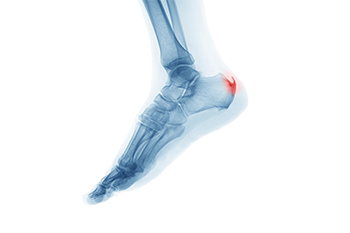
A calcium deposit that grows under the heel bone is known as a heel spur. It can be uncomfortable, and many people will alter their gait or walking style to accommodate the pain it can cause. A heel spur can gradually develop as a result of ligament or muscle strain, and heel pain is a common beginning symptom. People who stand on hard or uneven surfaces for the majority of the day may be prone to developing a heel spur, or it may happen to patients who have gained weight. It is beneficial to seek help from a podiatrist who can effectively diagnose a heel spur. Relief may be found when custom-made orthotics are worn, and specific stretches are routinely performed that can help to strengthen the heel muscles. It is helpful to wear shoes that fit correctly, with extra cushioning in the heel area. If you have developed a heel spur, it is suggested that you are under the care of a podiatrist who can offer you treatment methods that are correct for you.
Heel spurs can be incredibly painful and sometimes may make you unable to participate in physical activities. To get medical care for your heel spurs, contact one of our podiatrists from Crosstown Podiatry. Our doctors will do everything possible to treat your condition.
Heels Spurs
Heel spurs are formed by calcium deposits on the back of the foot where the heel is. This can also be caused by small fragments of bone breaking off one section of the foot, attaching onto the back of the foot. Heel spurs can also be bone growth on the back of the foot and may grow in the direction of the arch of the foot.
Older individuals usually suffer from heel spurs and pain sometimes intensifies with age. One of the main condition's spurs are related to is plantar fasciitis.
Pain
The pain associated with spurs is often because of weight placed on the feet. When someone is walking, their entire weight is concentrated on the feet. Bone spurs then have the tendency to affect other bones and tissues around the foot. As the pain continues, the feet will become tender and sensitive over time.
Treatments
There are many ways to treat heel spurs. If one is suffering from heel spurs in conjunction with pain, there are several methods for healing. Medication, surgery, and herbal care are some options.
If you have any questions feel free to contact our offices located in Wayne, Montclair, and Randolph, NJ . We offer the latest in diagnostic and treatment technology to meet your needs.
